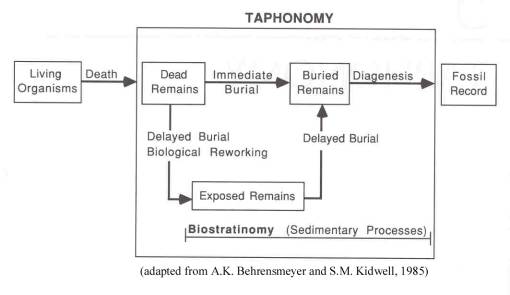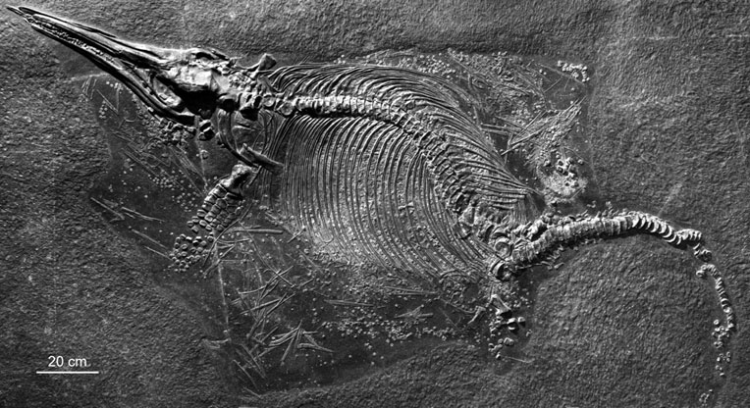Mesozoic Marine Reptiles – ichthyosaur Taphonomy
Only a small part of what once existed was buried in the ground: only a small part of what was buried has escaped the destroying hand of time: of this part all not yet come to light again: and we all know only too little of what has come to light has been of service for our science. (O. Montelius 1888:5)
Taphonomy is the science of the laws of burial or embedding. This includes decomposition, post-mortem transport, burial, compaction, and other chemical, biological or physical activity which affects the remains of the organism.
Vertebrate Preservation
Being able to recognize taphonomic processes that have taken place can often lead to a better understanding of paleoenvironments and even life-history of the once-living organism. Taphonomy is used to explore how and why organisms are preserved
Exceptional Preservation: Lagerstätten Deposits Posidinienscheifer
Formation Germany
Example of a female Stenopterygius. Embyros are within the skeleton. Disarticulation of foetus bones outside the parent body suggests possible implosion.
Conditions for burial:
The Formation comprises of Black Shale of up to 150m thick, laminated and show poor bioturbation. These shales attributed to a stagnant basin forming deposits. The environment would have been formed from oxygen poor bottom waters which were anoxic and inhibited bacterial decay allowing for preservation through diagenic purposes.
Anoxia:
The anoxic or disoxic water conditions of the time would help explain why there is so many ichthyosaur and marine vertebrate found among this sequence. Conditions would have been hostile preventing the opportunity for scavengers to disturb the embedding of the ichthyosaur within the soft sediment.
Rapid Burial:
The soft or “soupy” sediment was fundamental in the preservation of vertebrate fossils within the shale formation. This allowed the organism to sink fully articulated. It is thought that the Sternopterygius was only partially covering sediment. Lending for no preservation and decay of soft tissues (ligaments, cartilage) holding the bones. The remains would have remained this way for some time.
Soft Tissue Preservation:
The Posidonian deposits have also been important because of the rare soft tissue deposits among the Ichthyosaurus fossils. These soft tissue preservation indicated they possessed pectoral fins, dorsal fins and broad tails.
Articulation and Disarticulation:
This female Stenopterygius fossil has puzzled scientists. Assuming that the fossil fell to the sea floor postmortem, how is it that a fossil could become preserved nearly fully articulated, and almost in its anatomical position while the embryos have become disarticulated and dispersed around the parent body?
Posodian Shale Formation
Theories for exceptional preservation:
- Bottom current caused smaller bones to be moved. The disparity with this theory is that smaller parent bones would also have been moved by bottom current i.e. phalanges (finger bones) on paddles.
- Carcass explosion (Reisdorf et al. 2012). The gases that built up from decomposition could have caused the Stenopterygius to explode thus expelling the embyros disarticulated. The disparity with this theory is that the environment in which the ichthyosaur died in would have made it near impossible to explode. Assuming that the remains sink to death (150m), explosion at this depth would defy the laws of physics as the pressure surrounding the remains would have been much greater than the pressure within the remains. It is also thought that putrification (decomposition) slows with the drop in sea temperature.
- Carcass Implosion (Van Loon 2013) Loon agreed with Reisdorf that the corpse would sink and decompose. However, he proposed that the putrification gases would build up and that a wall that was damaged or scavenged would erupt. Water rushed in due to the pressure difference inside and outside the carcass. Turbulent water removed some of the embryos but not strong enough to affect parent body. Small embryo remains were moved outside of the body.
Van Loon A. J 2013: Ichthyosaur embryos outside the mother body: not due to carcass explosion but carcass implosion.
References
Books:
Paleoecology: Ecosystems, environments and Evolution. Patrick J. Brenchley and David A.T. Harper
Vertebrate Taphonomy: R.Lee Lyman
Introduction to Paleobiology and the Fossil Record: Michael J, Benton and David A.T Harpers:
Scientific Papers:
Van Loon A. J 2013: Ichthyosaur embryos outside the mother body: not due to carcass explosion but carcass implosion.
Reisdorf et. al 2012: Float explode or sink: post-mortem fate of lung breathing marine vertebrate.
Images:
Taphonomy Diagram – Adopted from A.K Verhrensmeyer & S, M Kidwell 1985
Stenopterygius – Van Loon A. J 2013: Ichthyosaur embryos outside the mother body: not due to carcass explosion but carcass implosion.
Podisonian Shale – Universitat Tubingen Manuela Aiglstorfer


![1331069db9[1]](https://biomgroup.files.wordpress.com/2014/01/1331069db91.jpg?w=692&h=243)

Here there, check the reply on van Loon (2013) by Reisdorf et al. (2014): http://link.springer.com/article/10.1007/s12549-014-0162-z